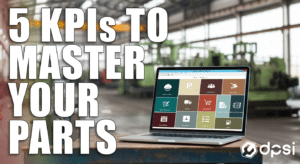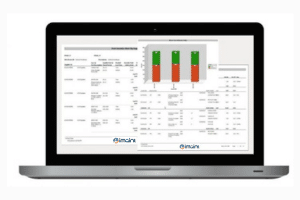Why is Inventory Tracking So Important?
In order to properly maintain equipment and facilities, maintenance departments must have parts available when needed. If there isn’t an accurate way to track inventory, this can result in many issues including parts not being available for maintenance repairs when needed, equipment downtime, costly special shipping and lost or stolen parts. Also, inventory has an impact on the profit margins of an organization due to high carrying costs. A CMMS software program can meet and remove a majority of challenges associated with inventory tracking.
What Challenges are Associated with Manual Inventory Tracking?
Difficulty locating and tracking parts: With a manual system, parts in various locations may be hard to locate when needed. This leads to reordering, overstocking and/or the stocking of obsolete parts, which can be hard to manage. The end result is increased inventory carrying costs for the organization, as well unplanned equipment downtime and lost productivity if parts aren’t available when needed.
How CMMS Helps: Parts, along with their specific information, can easily be located in any area of the facility (or outside plant, if multiple locations exist) using CMMS inventory tracking features. Parts can be found by any criteria including supplier, vendor, manufacturer part number, serial number, part type (all filters or bearing), etc. All quantities are automatically tracked, including links to the work order and purchasing modules in the CMMS system. Automating and organizing the task of tracking parts has many benefits. Examples include reduced inventory carrying costs (parts are ordered only as needed) along with reduced equipment downtime and lost productivity (parts are available when needed).
Difficulty tracking quantities and re-order points: All quantities such as on-hand, on-order, receipts, committed and issues result in many transactions that must be tracked manually. This can result in frequent discrepancies, since errors are more common in data that has been inputted manually. Re-order points and methods must also be tracked manually.
How a CMMS Helps: All quantities (on-hand, on-order, receipts, committed and issues) are automatically tracked, greatly reducing discrepancies. Automatic reorder points can be established within the CMMS, and when inventory falls below safety stock or designated reordering methods, parts will be placed on order with the preferred vendor.
Difficulty tracking multiple vendors and suppliers: With a manual system, it can be difficult to track various vendors who provide the same basic part, including the suppliers who offer them. Without the ability to track the lowest price provider and lead time, companies typically experience in higher purchase costs and longer lead times. This is especially true if parts have to be ordered with short lead times and high shipping costs.
How a CMMS Helps: A CMMS system gives maintenance departments the ability to track the lowest price provider and lead time, which results in lower purchase costs and shorter lead times. Tracking vendors and suppliers with CMMS software is a more manageable and efficient method.
Difficulty tracking future forecasted needs: With a manual system in place, it is difficult to track future part needs by time period, factoring in order lead times, for future planned maintenance jobs.
How a CMMS Helps: Companies can track part needs by time period, factoring in order lead times by vendor. This leads to proper planning and management of work orders with the necessary parts available when needed.
Difficulty performing physical counts and reconciliations: A manual system can make this job labor intensive, particularly when performing partial counts for high value or frequently used parts only.
How CMMS Helps: Physical counts can easily be managed with a CMMS system, including performing partial counts for high value or frequently used parts. When counted quantities are entered, they are automatically reconciled with on-hand quantities and any discrepancies are corrected.
Reporting and analysis is labor intensive or unavailable: A history of inventory purchases and usage by any time period, by vendor, including the equipment a part was installed on, is very difficult to compile manually.
How CMMS Helps: An extensive history of inventory is available at the user’s fingertips for any criteria using reports, graphs or dashboards. This includes for any time period, for any type of transaction (order, receipt, issue, on-hand adjustment) by part, part description, part class, vendor, etc.
CMMS Software Decreases Costs Associated with Inventory Tracking
Once asset data is entered successfully and consistently, according to standard operating procedures set forth in your CMMS system, users can set up schedules within for each each individual piece of equipment. Specific parts and inventory can be automatically reordered based on quantity level thresholds set up in the CMMS. This helps ensure companies have an appropriate amount of spare parts and inventory, without overstocking and overspending. It also helps reduce the risk of not having enough of the parts available when they’re really needed, which could result in unplanned equipment downtime and lag in production. CMMS software also helps upper management make smarter asset management decisions by providing accurate and reliable equipment data to analyze. Equipment generally can be used much longer overall it’s successfully maintained, and funds otherwise allocated to machine replacements can be put to better use. CMMS software enhances productivity for the entire maintenance team and, thus, organization as a whole. Employees can make better use of their time by utilizing updated methods of managing maintenance and eliminating outdated, manual procedures. Overall, maintenance management software can help companies benefit from significant cost-saving opportunities.
Interested in Trying Out CMMS Software?
DPSI’s systems provide the features and functions necessary for maintenance teams to effectively manage parts inventory. We have been a global leader in maintenance management software since 1986. Our solutions help organizations manage, monitor and control maintenance including equipment, resources, parts and regulatory compliance. See for yourself how DPSI’s CMMS inventory tracking feature, along with many other powerful tools within the software, can make your company more productive. Get started with a free trial today.





